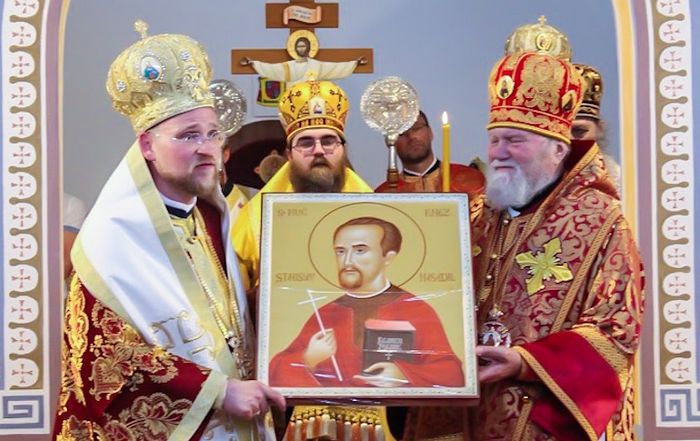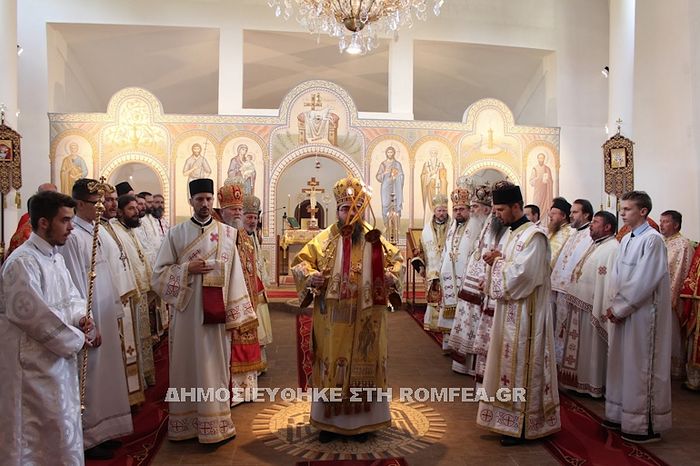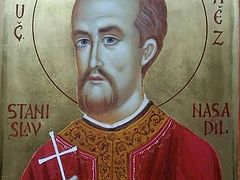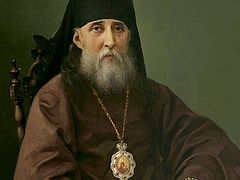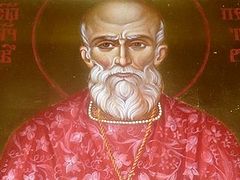Košice, Slovakia, June 14, 2019
Hieromartyr Stanislav Nasadil was canonized by the Serbian Orthodox Church in 1961. The Church in Czechoslovakia was a canonical part of the Serbian Orthodox Church at the time of St. Stanislav’s martyrdom in 1941.
The now-autocephalous Church of the Czech Lands and Slovakia recently officially added him to its liturgical calendar, and on Sunday, the Church celebrated his glorification, together with hierarchs from the Serbian and Polish Orthodox Churches.
The Liturgy with the act of canonization was celebrated at the Cathedral of the Dormition and St. John the Merciful in Košice, Slovakia by His Beatitude Metropolitan Rostislav of Prešov, the primate of the Church of the Czech Lands and Slovakia, with the assistance of several other hierarchs and priests from the Czech-Slovak Church and the Churches of Serbia and Poland, reports Orthodoxie.
During the Liturgy, the decision of the Holy Synod regarding the canonization of St. Stanislav was read out and signed by all the hierarchs and priests present, as well as the hieromartyr’s great grandson, Monk Paisije of Kovilj Monastery in Serbia.
A homily was offered by His Grace Bishop Irinej of Bačka of the Serbian Orthodox Church:
“In the holy Gospel according to St. John, of which we have just read a passage, we hear how the Savior said to His faithful disciples: You are my friends! I no longer call you servants, but My friends. Then the Savior declares that if men of this world persecuted Him, His followers will be persecuted as well. These two messages by our Savior were realized in a wonderful saint of God, the holy Hieromartyr Stanislav Nasadil, who is at the same time a friend of God by his virtues, and a martyr for Christ, who gave his life for his neighbor and for his spiritual flock. There is no greater love than that.
“In our Orthodox Church, love and unity among all is the fundamental principle of existence and life. This springs forth from the Divine Liturgy, because we receive in the Divine Communion the one Body of the Lord Christ, and we unite with the Lord. This unity is the source of all the unity of the Church in the world. The Liturgy is not a means by which we will attain the unity of the Church, but it is its goal and crowning achievement, because only in the Liturgy do we truly experience the unity of the Church. The Lord is one in the Holy Trinity, and all of us, though different, as peoples, but perhaps also in our culture, are nevertheless one in Christ, the God-Man.
“After the Lord Who unites us, the saints of God, His friends, as He calls them, also unite us in His name and grace. The unity they show and grant us concerns all the Orthodox. However, we notice some historical dimensions which give us particular feelings of joy and gratitude to the Lord. You all know the historical and spiritual connections between the Serbian Church and your Church in the Czech Lands and Slovakia. Our spiritual leaders, and among them saints who are already glorified, were here the spiritual pastors of your ascendants, between the two world wars.
“In the same way, many sons of your neighboring nations, Slovakia and Czechia, lived in our country and witnessed there to their Orthodox faith, as saints and martyrs, showing what it means to be a friend of Christ.
“The greatest example is the Hieromartyr Stanislav, whom we glorify today as a saint. He was Czech by birth, but served as a priest in the Serbian Orthodox Church, in a diocese which is in Croatia. During World War II, a horrible regime was in power, a satellite of the Nazi regime, which persecuted among others Orthodox Serbs, Gypsies, Jews, and anti-Nazis Croats.
“The result of this criminal government system is that three of our bishops were martyred, as well as hundreds of priests, and hundreds of thousands of faithful, who suffered for the sole reason that they were Orthodox.
“Nevertheless, in all this inhumanity, rulers showed a small spark of humanity. To those who were not from these areas, they said they could leave, because they were foreigners. That’s what they said to our bishops, but these refused, saying, ‘We are here with our spiritual children and we cannot abandon them.’
“That’s what the holy Hieromartyr Stanislav did. He could have left his parish, his faithful, and survive. He could have said he was neither Serbian nor Jewish, but Czech, and leave. But he did not want to leave his spiritual children. So he paid with his life, witnessing what it means to be a true priest of the Church of Christ. That is why the Lord has glorified Him, so that today we may pray to him.
“I will add something that causes joy and a strong feeling in me. The first reason is that my predecessor, the saint and great Bishop Irinej (Ćirić), ordained Father Stanislav to the diaconate and the priesthood. The other reason is that today, by Divine Providence, his great grandson, Monk Paisije of Kovilj Monastery, in our diocese of Bačka, is here with us.
“Thus the Lord glorifies His true friends, and calls us all to do everything we can in our life to also become His friends, as are the saints, and as is the holy Hieromartyr Stanislav. That is why the Lord came in the flesh, that is why He sent the Holy Spirit, and that is why His Church exists, so that we may all be deified by His grace.
“Thus, the saints of God, the martyrs and others, are not a kind of superhuman beings for us, Orthodox Christians. They are like us, men and women of flesh and blood, but they loved the Lord Christ and have become one with Him, as He is one with the Father.
“Thus the holy Hieromartyr Stanislav, at first glance a mere and insignificant parish priest in a small province, will from today on be glorified throughout the world and throughout the Orthodox Church as a saint. He, and others like him, are the true glory and praise of both your local Church and the whole Orthodox Church.
“Saint Hieromartyr Stanislav, pray to God for us!”
The New Martyr Stanislav will be celebrated annually on June 20, the day of his martyrdom.
***
St. Stanislav was born on October 20, 1907 in the town of Loštice in the former Czechoslovakia.
He studied theology in Yugoslavia from 1923 to 1928 and later served as a priest in Lička Jesenica in Croatia. During the Second World War, Fr. Stanislav was one of thousands of victims of the Ustaşa separatist movement in Croatia.
He was arrested on June 17, 1941 in Plaški, Croatia together with his bishop, Hieromartyr Sava (Trlajić), and was killed with a hammer in the Gospić camp in Herzegovina three days later, after being tortured by the Ustaşa criminal Josip Tomljenović. His body was discovered in a mass grave in the Jadonovo Caves.
Follow us on Facebook!

